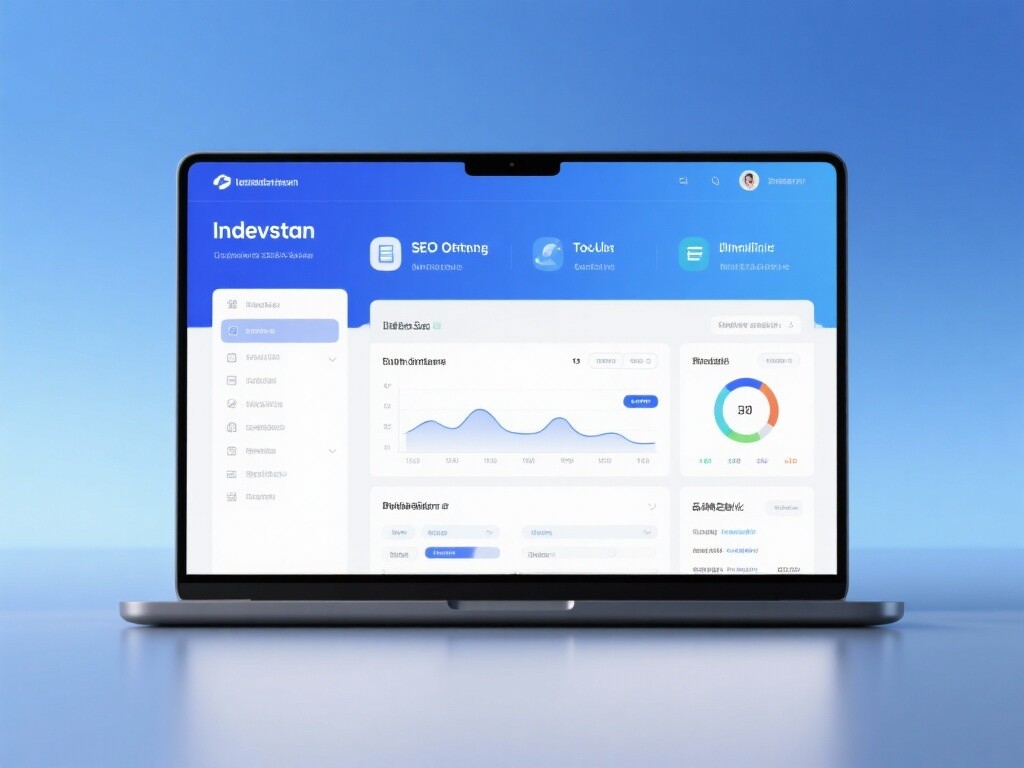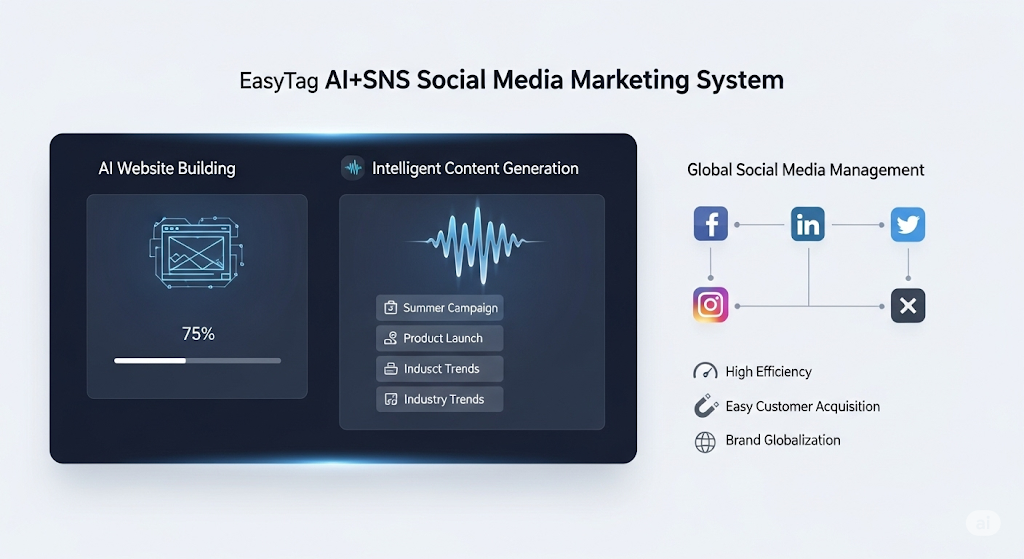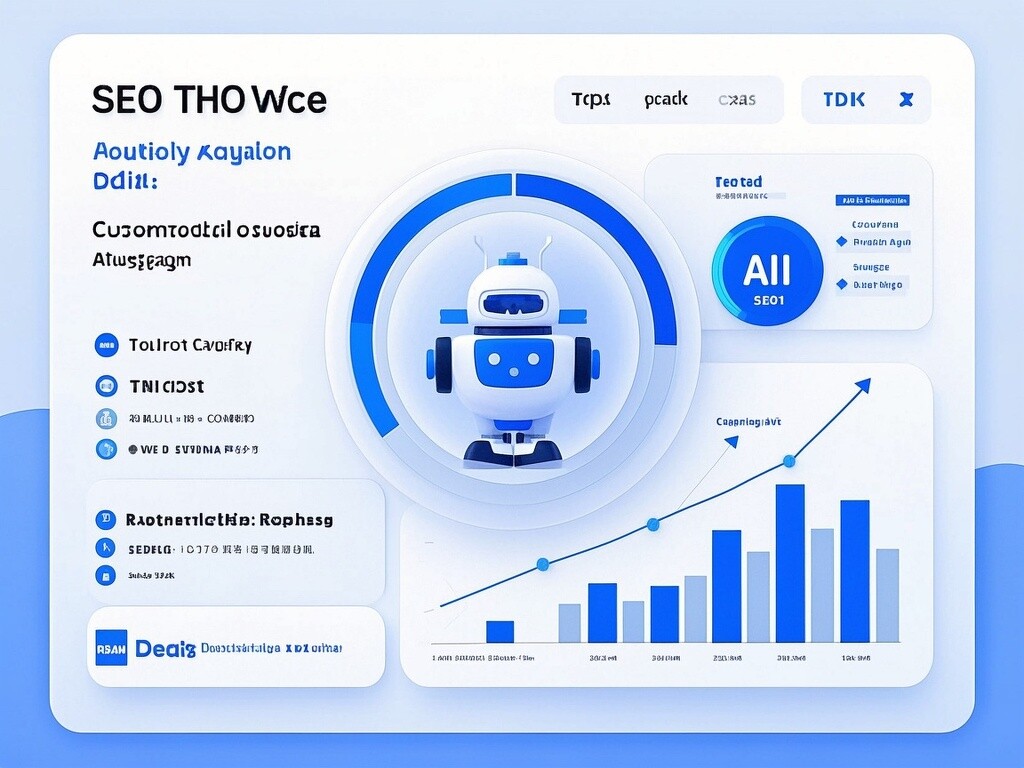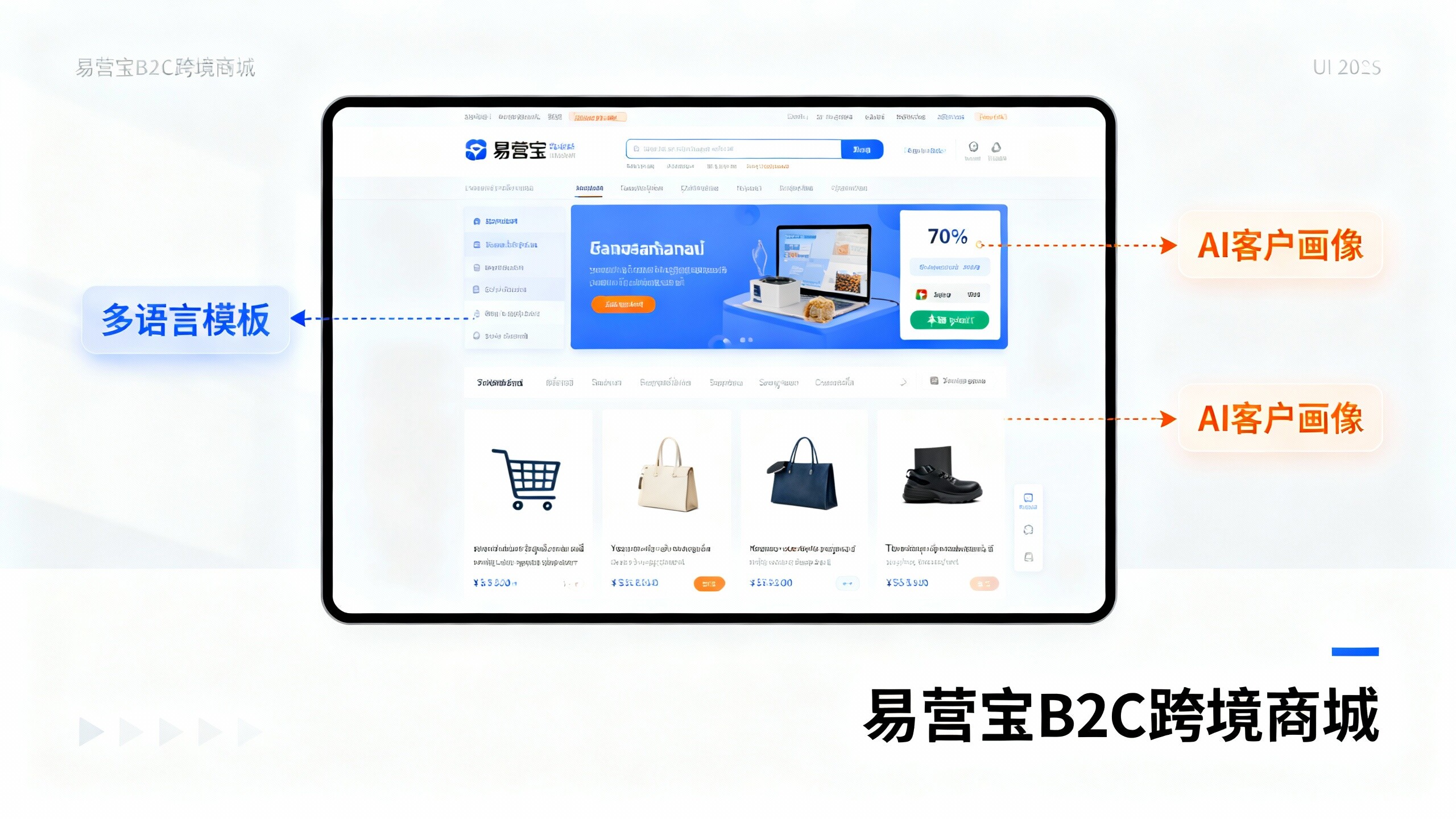Definition of an Independent Website: A Fully Self-Controlled E-Commerce Digital Asset
Independent E-commerce Website (Independent E-commerce Website), typically refers to a seller-ownedindependent domain name, proprietary brand, and an online sales platform built and operated on independent servers or e-commerce website systems. Its key distinction from third-party e-commerce platforms (such as Amazon, eBay, Alibaba International, etc.) lies incontrol rights and data ownership.
Four Core Elements of an Independent Website:
Independent Domain Name (Domain Name): The website possesses a unique brand domain name, serving as the carrier of brand assets.
Data Ownership (Data Ownership): The seller fully owns all user data, transaction data, and traffic data.
Brand Customization (Brand Customization): The website's design, functionality, and marketing strategies are entirely determined by the seller, free from platform rule restrictions.
Decentralized Traffic (Decentralized Traffic): Traffic primarily relies on self-owned paid channels (such as Google Ads, Facebook Ads) and free channels (such as SEO-driven organic search traffic).
Strategic Value of an Independent Website: Transition from "renting" platform traffic to "owning" proprietary traffic and brand.
Development History of Independent Websites: From High-Barrier Enterprises to SaaS-Driven Popularization
The development history of independent websites reflects the continuous maturation of e-commerce technology, logistics supply chains, and global payment systems:
1. Early Stage: Self-Building and High Technical Barriers (1990s-2005)
Technical Features: Independent websites were primarily built by large enterprises or companies with strong technical teams through**custom programming or open-source systems (such as early versions of Magento)**.
Barriers: Extremely high technical and operational costs, significant challenges in integrating payment and logistics, making it difficult for small and medium-sized enterprises to enter.
2. Platform Rise and Independent Website Decline (2005-2015):
Trend: The global emergence ofthird-party platformsrepresented by Amazon and eBay, leveraging their massive traffic advantages and robust infrastructure to attract numerous sellers.
Challenge: The difficulty in acquiring traffic and relatively high operational costs for independent websites once made them a non-mainstream choice.
3. SaaS Website Building and Cross-Border E-Commerce Boom (2015-Present):
Technical Revolution: The maturation and popularization of SaaS/open-source website systems likeShopify, ShopBase, WooCommerce. These systems significantlylowered technical barriers and operational costs, enabling small and medium-sized enterprises to quickly build fully functional independent websites.
Traffic Transformation: With the maturation ofprecision advertising toolslike Facebook and Google Ads, as well as the professionalization of SEO strategies, the traffic acquisition capabilities of independent websites greatly improved.
Branding Trend: Increasing numbers of sellers recognize the importance ofbrand and data autonomy, shifting from platforms to independent websites or adopting a "platform + independent website" dual-operation model.
Today,independent websiteshave become the mainstream model in cross-border trade forhigh value-added, long-term brand building.
Technical Principles of Independent Websites: CMS Architecture and Payment-Logistics Integration
The stability and scalability of independent websites depend on their underlying technical architecture, primarily based on CMS (Content Management System) and key third-party service integrations.
1. Core Principles of CMS Architecture
Principle: Independent websites are typically built on mature CMS/website systems, which providefront-end templates, back-end databases, content editors, and core e-commerce functionalities (shopping cart, checkout).
Mainstream Systems and Their Principles:
SaaS Model (e.g., Shopify): Cloud-hosted, eliminating seller concerns about servers, security, and maintenance. The system handles alltraffic scalingandsecurity updates.
Open-Source Model (e.g., WooCommerce/Magento): Sellers need tohost their own serversbut have completecode modification and customizationfreedom.
2. Payment Gateway Integration Principles
Principle: Independent websites do not have built-in payment functionalities and require integration withthird-party payment service providers(such as PayPal, Stripe, international credit card gateways) viaAPI interfaces.
Security Core: Payment processes must comply with **PCI DSS (Payment Card Industry Data Security Standard)** certification to ensure the security of users' credit card information during transmission. Independent websites must deploy SSL certificatesto enable secure encrypted communication with payment gateways.
3. Logistics and Warehouse System Integration Principles
Principle: Connect tologistics service providers(such as DHL, FedEx, Cainiao) orERP systemsvia API interfaces.
Functionality Implementation: Automatically retrieve real-time shipping quotes, generate tracking numbers, update order statuses, and achieveinventory synchronization and order fulfillment automation.
4. Data Tracking and Attribution Principles
Principle: Deploy **Google Analytics 4 (GA4)** and Google Ads conversion tracking, Facebook Pixel codes.
Value: Monitor user behavior, ad performance, and conversion leaks in real-time, enablingprecise attribution of multi-channel traffic, the foundation of data-driven marketing.
Technical Features and Core Advantages of Independent Websites
Independent websites leverage their autonomy to offer unparalleled advantages in branding, data, and marketing compared to third-party platforms.
1. Brand Assets and User Mindshare
Feature: Complete freedom in design and content control.
Advantage: Enables deep brand culture immersion and storytelling, buildinglong-term brand loyalty. Users remember your domain name and brand, not the platform store name.
2. Data Ownership and Remarketing Potential
Feature: 100% ownership of all customer data (email, behavior paths, purchase history).
Advantage: Utilize this data forhighly targeted email marketing, precision remarketing (Remarketing), and building high-valueprivate traffic, significantly improvingrepurchase rate (Repurchase Rate).
3. High Profit Margins and Pricing Freedom
Feature: No need to pay highsales commissions and ad traffic feesto platforms (or significantly reduced fees).
Advantage: Greatly increasesgross profit margins, providing more budget space for product development, brand building, and market promotion.
4. SEO Strategy and Organic Traffic Accumulation
Feature: Complete control over website content and technical architecture, enabling deepSEO optimization.
Advantage: Through continuous SEO investment, accumulatefree, high-qualityorganic search traffic. Unlike platform traffic, once established, SEO traffic for independent websites offerslong-term stability and low acquisition costs.
5. Unlimited Expansion of Marketing Tools and Functionalities
Feature: Can integrate various marketing tools (such as pop-ups, AB testing tools, subscription plugins, localized apps).
Advantage: Easily implementpersonalized recommendations, A/B testingandmarketing automationto improve conversion rates (CRO).
Deep Applications and SEO Strategies for Independent Websites
Successful independent website operations require transforming technical advantages into traffic and conversion effects.
1. Keyword Strategy: Product Pages and Content Marketing
Application: SEO strategies should be divided into two parts:
Product Pages/Category Pages: Optimize forhigh-intent purchase keywords(e.g., "Best Noise-Cancelling Headphones 2025").
Blog/Content Hub: Create in-depth content around industry themes and user pain points to capturelong-tail traffic and brand trust.
Value: Leverage content marketing to acquirefree, high-intentsearch traffic, reducing reliance on paid ads.
2. Website Speed and User Experience Optimization
Application: Independent websites often contain large amounts of images and scripts, necessitating optimization of Core Web Vitals metrics.
Value: Optimize **LCP (Largest Contentful Paint)** and CLS (Cumulative Layout Shift)to ensure users receive an ultra-fast experience across different devices, reducing bounce rates andimproving conversion rates.
3. Localization and Multilingual SEO
Application: For multi-country markets, implementmultilingual website architectureand correct
hreflangtagsto ensure different language versions are properly indexed by local search engines.Value: Achieveprecise localization(e.g., currency, payment, language preferences), enhancing trust and conversion rates among target market users.
4. Remarketing and Customer Lifetime Value (LTV)
Application: Use email and behavioral data collected by independent websites forautomated email win-back, repurchase discount campaigns.
Value: Significantly increasecustomer lifetime value (LTV), making the initial traffic acquisition cost (CAC) more economically efficient.
EasyProfit: Your Independent Website Construction and Growth Strategy Expert
EasyProfit is not just an SEO expert but also a full-chain partner helping yousuccessfully build and operate high-conversion independent websites. We offer:
Independent Website Platform Selection and Architecture Consulting: Based on your product, market, and budget, provide professional recommendations for Shopify/WooCommerce/custom development.
One-Stop Technical SEO Deployment: Ensure your independent website completes all key technical configurations before launch, including URL standardization, Core Web Vitals optimization, mobile adaptation, and
hreflangtags.High-Conversion Content Marketing Strategies: Developglobal keyword strategiescovering product pages, category pages, and content hubs to ensure each page targets high-value traffic.
Data Tracking and Attribution System Setup: Assist in correctly deploying GA4, conversion APIs, and establishing a clearad ROI and SEO performance measurement system.
CRO (Conversion Rate Optimization): Conduct A/B testing and optimization on the checkout flow, product page layouts, and CTAs of independent websites,transforming traffic into actual orders.
EasyProfit is committed to making yourindependent websiteabrand-accumulating, data-autonomous, highly profitableglobal e-commerce stronghold.
FAQ
1. Should I choose an independent website or a third-party platform (such as Amazon)?
We recommend adopting a dual-track strategy, but an independent website is a long-term asset.
Third-party platforms: Suitable for quick launch, market testing, and leveraging the platform's massive built-in traffic. The drawbacks are high commission fees and limited data access.
Independent websites: Suitable for brand building, accumulating private domain traffic, and pursuing high-profit margins. The drawback is the need for upfront time and budget investment to acquire traffic. Final strategy: Test products on platforms, then use the independent website to build brand moat and long-term competitiveness.
2. Where does the traffic for an independent website mainly come from? Is SEO traffic important?
The traffic for an independent website mainly comes from two major channels:
Paid traffic (SEM): Google Ads, Facebook/Instagram Ads, and other social media advertising. This is key for launching and rapid scaling.
Organic traffic (SEO): Free traffic from search engines like Google/Bing. This is key for reducing long-term operational costs and accumulating brand assets. SEO traffic is extremely important because it has the lowest cost, precise intent, and offers sustained, stable compound effects. The operational goal of a professional independent website is to gradually shift the traffic structure from being primarily paid to a balance of paid and organic traffic.
3. What are the most common SEO mistakes in independent website operations?
The most common mistakes are technical SEO deficiencies and thin content:
Technical deficiencies: Incorrect Canonical tags or redirect chains, preventing search engines from properly indexing product pages.
Thin content: Product descriptions are merely copied, lacking originality, depth, and user value, making it impossible to rank.
Slow speed: Unoptimized images and scripts lead to slow website loading and high bounce rates.

Customer Reviews
Mr. Dong, CEO of a new outdoor equipment brand
"We operated on the Amazon platform for two years. Although we had sales, our profits were constantly squeezed by high commission fees. With the guidance of EasyYunBao, we built an independent website based on Shopify. They not only helped us complete all technical SEO configurations but also developed a high-value blog content strategy. Now, 40% of our monthly traffic comes from free organic search, and the keyword 'Best Camping Gear' has already ranked on the first page of Google. The independent website not only improved our profit margins but, more importantly, brand loyalty and repurchase rates are something we couldn't have imagined before."
Ms. Meng, a B2B industrial product cross-border trader
"As a B2B enterprise, we value data ownership and inquiry quality the most. EasyYunBao built a deeply customized independent website based on WooCommerce for us and integrated complex GA4 and CRM systems. Through SEO optimization, they locked the traffic precisely onto high-intent industry jargon keywords. Now, although the number of inquiries from our independent website is not as high as on platforms, the success rate of inquiries converting into orders has increased by 25%, proving the precision and high value of independent website traffic."
![From niche products to global leader in gardening tools - what did it do right? From niche products to global leader in gardening tools - what did it do right?]() From niche products to global leader in gardening tools - what did it do right?VEVOR successfully transitioned from niche products to becoming a global leader in gardening tools by accurately identifying user needs, innovating product designs, and implementing unique marketing strategies. Its independent website features specialized product categories, DIY project modules, and blog sections, effectively enhancing brand visibility and user engagement, providing valuable experience for cross-border brands.
From niche products to global leader in gardening tools - what did it do right?VEVOR successfully transitioned from niche products to becoming a global leader in gardening tools by accurately identifying user needs, innovating product designs, and implementing unique marketing strategies. Its independent website features specialized product categories, DIY project modules, and blog sections, effectively enhancing brand visibility and user engagement, providing valuable experience for cross-border brands.![Annual revenue exceeding 10 million, transitioning from auto parts to energy storage, niche markets achieve major sales! (Part 2) Annual revenue exceeding 10 million, transitioning from auto parts to energy storage, niche markets achieve major sales! (Part 2)]() Annual revenue exceeding 10 million, transitioning from auto parts to energy storage, niche markets achieve major sales! (Part 2)Exploring how Datou Hardware Products Co., Ltd. successfully pivoted from auto parts to energy storage by establishing the standalone brand website DATOU BOSS and implementing precise marketing strategies to expand overseas markets, achieving annual revenue exceeding 10 million.
Annual revenue exceeding 10 million, transitioning from auto parts to energy storage, niche markets achieve major sales! (Part 2)Exploring how Datou Hardware Products Co., Ltd. successfully pivoted from auto parts to energy storage by establishing the standalone brand website DATOU BOSS and implementing precise marketing strategies to expand overseas markets, achieving annual revenue exceeding 10 million.![China's Machinery Export New Pathway: Can You Capture Middle East & Latin America Red Profits Amid the GCC Construction Wave? China's Machinery Export New Pathway: Can You Capture Middle East & Latin America Red Profits Amid the GCC Construction Wave?]() China's Machinery Export New Pathway: Can You Capture Middle East & Latin America Red Profits Amid the GCC Construction Wave?How Can Chinese Machinery Break Through in Middle East & Latin American Emerging Markets via Differentiated Social Media Operations? Let's Explore Deeply!
China's Machinery Export New Pathway: Can You Capture Middle East & Latin America Red Profits Amid the GCC Construction Wave?How Can Chinese Machinery Break Through in Middle East & Latin American Emerging Markets via Differentiated Social Media Operations? Let's Explore Deeply!![The Battleground for Foreign Trade: Google Marketing's Five Core Advantages – What Are You Waiting For? The Battleground for Foreign Trade: Google Marketing's Five Core Advantages – What Are You Waiting For?]() The Battleground for Foreign Trade: Google Marketing's Five Core Advantages – What Are You Waiting For?How Can Foreign Trade Companies Stand Firm in the Global Market? Google Marketing's Five Advantages Reveal the Answer!
The Battleground for Foreign Trade: Google Marketing's Five Core Advantages – What Are You Waiting For?How Can Foreign Trade Companies Stand Firm in the Global Market? Google Marketing's Five Advantages Reveal the Answer!![Small factories counterattack overseas! Three micro-brand strategies make customers line up to place orders. Dare to try? Small factories counterattack overseas! Three micro-brand strategies make customers line up to place orders. Dare to try?]() Small factories counterattack overseas! Three micro-brand strategies make customers line up to place orders. Dare to try?How can small foreign trade businesses counterattack? Micro-brand tactics double your profits, with customers chasing to place orders!
Small factories counterattack overseas! Three micro-brand strategies make customers line up to place orders. Dare to try?How can small foreign trade businesses counterattack? Micro-brand tactics double your profits, with customers chasing to place orders!![Why was your Facebook account suddenly banned? The 6 digital gulfs that cross-border marketing must overcome! Why was your Facebook account suddenly banned? The 6 digital gulfs that cross-border marketing must overcome!]() Why was your Facebook account suddenly banned? The 6 digital gulfs that cross-border marketing must overcome!In the wave of cross-border digital marketing, 65% of foreign trade enterprises have encountered Facebook account anomalies. This article analyzes the six major banned minefields and reveals the survival rules of multilingual operations and compliance.
Why was your Facebook account suddenly banned? The 6 digital gulfs that cross-border marketing must overcome!In the wave of cross-border digital marketing, 65% of foreign trade enterprises have encountered Facebook account anomalies. This article analyzes the six major banned minefields and reveals the survival rules of multilingual operations and compliance.![As the Asian economic landscape undergoes restructuring, how can your business leverage multilingual foundations to capture the trillion-dollar Southeast Asian market? As the Asian economic landscape undergoes restructuring, how can your business leverage multilingual foundations to capture the trillion-dollar Southeast Asian market?]() As the Asian economic landscape undergoes restructuring, how can your business leverage multilingual foundations to capture the trillion-dollar Southeast Asian market?In the wave of RCEP agreement deepening and Asian supply chain restructuring, Vietnam, Malaysia, and Cambodia are becoming new growth poles. Easypower AI multilingual website systems help businesses break through language barriers and seize the Southeast Asian digital commerce opportunity.
As the Asian economic landscape undergoes restructuring, how can your business leverage multilingual foundations to capture the trillion-dollar Southeast Asian market?In the wave of RCEP agreement deepening and Asian supply chain restructuring, Vietnam, Malaysia, and Cambodia are becoming new growth poles. Easypower AI multilingual website systems help businesses break through language barriers and seize the Southeast Asian digital commerce opportunity.![From 0 to 20 Million Orders: The 'Cold Start' Secret for B2B Enterprises in Google Ads From 0 to 20 Million Orders: The 'Cold Start' Secret for B2B Enterprises in Google Ads]() From 0 to 20 Million Orders: The 'Cold Start' Secret for B2B Enterprises in Google AdsUnveiling how B2B enterprises achieve cold start through Google Ads, rapidly growing from 0 to 20 million orders. Includes practical strategies like keyword tactics, ad structure segmentation, and landing page optimization to help foreign trade companies enhance marketing effectiveness and achieve business growth.
From 0 to 20 Million Orders: The 'Cold Start' Secret for B2B Enterprises in Google AdsUnveiling how B2B enterprises achieve cold start through Google Ads, rapidly growing from 0 to 20 million orders. Includes practical strategies like keyword tactics, ad structure segmentation, and landing page optimization to help foreign trade companies enhance marketing effectiveness and achieve business growth.
![AI+SNS Social Media Full Intelligent Marketing System AI+SNS Social Media Full Intelligent Marketing System]() AI+SNS Social Media Full Intelligent Marketing SystemEasyWin AI+SNS Social Media Full Intelligent Marketing System - Precision social capture in the social media era, supports one-click content synchronization across mainstream platforms like Facebook and LinkedIn, AI-powered post rewriting to enhance adaptability, 24/7 intelligent customer service with user persona analysis, helping businesses efficiently expand global markets.
AI+SNS Social Media Full Intelligent Marketing SystemEasyWin AI+SNS Social Media Full Intelligent Marketing System - Precision social capture in the social media era, supports one-click content synchronization across mainstream platforms like Facebook and LinkedIn, AI-powered post rewriting to enhance adaptability, 24/7 intelligent customer service with user persona analysis, helping businesses efficiently expand global markets.![SEO Optimization SEO Optimization]() SEO OptimizationEasyProfit provides professional SEO optimization services, including AI-powered article writing, product descriptions, keyword recommendations, keyword expansion, TDK generation, and image generation features, helping businesses improve search engine rankings and achieve precise marketing.
SEO OptimizationEasyProfit provides professional SEO optimization services, including AI-powered article writing, product descriptions, keyword recommendations, keyword expansion, TDK generation, and image generation features, helping businesses improve search engine rankings and achieve precise marketing.![EasyYunBao AMP/MIP Mobile Intelligent Website Building EasyYunBao AMP/MIP Mobile Intelligent Website Building]() EasyYunBao AMP/MIP Mobile Intelligent Website BuildingEasyYunBao Mobile Dual-Engine Independent Website System, supports independent creation of Google AMP multilingual mobile websites and Baidu MIP Chinese mobile websites, achieves millisecond-level loading through official acceleration technologies from Google and Baidu, improves search rankings and conversion rates, covering the two major global mobile search ecosystems.
EasyYunBao AMP/MIP Mobile Intelligent Website BuildingEasyYunBao Mobile Dual-Engine Independent Website System, supports independent creation of Google AMP multilingual mobile websites and Baidu MIP Chinese mobile websites, achieves millisecond-level loading through official acceleration technologies from Google and Baidu, improves search rankings and conversion rates, covering the two major global mobile search ecosystems.![B2B Foreign Trade Solutions B2B Foreign Trade Solutions]() B2B Foreign Trade SolutionsEasyTrade provides comprehensive B2B foreign trade solutions, offering end-to-end services from website development to brand recognition, inquiry acquisition, and order conversion. We help foreign trade enterprises build high-conversion independent websites, obtain precise inquiries, establish international brand images, and accumulate private domain traffic.
B2B Foreign Trade SolutionsEasyTrade provides comprehensive B2B foreign trade solutions, offering end-to-end services from website development to brand recognition, inquiry acquisition, and order conversion. We help foreign trade enterprises build high-conversion independent websites, obtain precise inquiries, establish international brand images, and accumulate private domain traffic.![EasyOperate B2C Cross-border E-commerce Platform, Independent Website EasyOperate B2C Cross-border E-commerce Platform, Independent Website]() EasyOperate B2C Cross-border E-commerce Platform, Independent WebsiteEasyStore B2C Cross-border E-commerce Independent Platform is an all-in-one intelligent website building and cross-border e-commerce solution independently developed by EasyStore Information Technology (Beijing) Co., Ltd. The system is specially designed for small and medium-sized as well as large export enterprises, integrating "website building, operation, marketing, advertising, and conversion" into one platform, helping enterprises quickly establish cross-border e-commerce independent websites to achieve brand globalization and global sales growth.
EasyOperate B2C Cross-border E-commerce Platform, Independent WebsiteEasyStore B2C Cross-border E-commerce Independent Platform is an all-in-one intelligent website building and cross-border e-commerce solution independently developed by EasyStore Information Technology (Beijing) Co., Ltd. The system is specially designed for small and medium-sized as well as large export enterprises, integrating "website building, operation, marketing, advertising, and conversion" into one platform, helping enterprises quickly establish cross-border e-commerce independent websites to achieve brand globalization and global sales growth.
The platform supports multiple languages, multiple currencies, and multi-channel marketing, with built-in AI intelligent translation and SEO optimization systems, suitable for mainstream markets such as Southeast Asia, Europe and America, Latin America, and the Middle East, assisting Chinese manufacturing enterprises in efficiently deploying international e-commerce strategies.![Global CDN Acceleration Empowers B2B Foreign Trade Website Building Global CDN Acceleration Empowers B2B Foreign Trade Website Building]() Global CDN Acceleration Empowers B2B Foreign Trade Website BuildingAgainst the backdrop of global trade digital transformation, export enterprises face the dual challenges of cross-border network latency and geographical information search (GEO) disparities. The 'Global CDN Acceleration Empowering B2B Export Website Building' solution launched by EasyCamp is not just a technology to enhance webpage loading speed, but a systematic engineering that integrates search engine optimization (SEO) with GEO. By establishing multi-center edge nodes worldwide, it ensures that overseas buyers can instantly access corporate websites regardless of their location, significantly enhancing brand first impressions and inquiry conversion rates.
Global CDN Acceleration Empowers B2B Foreign Trade Website BuildingAgainst the backdrop of global trade digital transformation, export enterprises face the dual challenges of cross-border network latency and geographical information search (GEO) disparities. The 'Global CDN Acceleration Empowering B2B Export Website Building' solution launched by EasyCamp is not just a technology to enhance webpage loading speed, but a systematic engineering that integrates search engine optimization (SEO) with GEO. By establishing multi-center edge nodes worldwide, it ensures that overseas buyers can instantly access corporate websites regardless of their location, significantly enhancing brand first impressions and inquiry conversion rates.


















